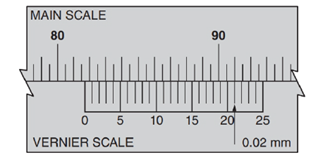
Mathematics For Machine Technology
8th Edition
ISBN: 9781337798310
Author: Peterson, John.
Publisher: Cengage Learning,
expand_more
expand_more
format_list_bulleted
Concept explainers
Textbook Question
Chapter 33, Problem 1A
Read the metric vernier caliper measurement for this setting.

Expert Solution & Answer
To determine
Find the metric Vernier caliper measurement for this given setting.
Answer to Problem 1A
Themetric Vernier caliper measurement is,
Explanation of Solution
Given:
The given setting is,

Calculation:
Given:

Read the main scale reading to the left of the zero graduation on the Vernier scale.
Eighty-one
The
The number of millimeters represented by
Vernier caliper reading
Hence the metric Vernier caliper measurement is,
Want to see more full solutions like this?
Subscribe now to access step-by-step solutions to millions of textbook problems written by subject matter experts!
Students have asked these similar questions
Use laplace transform to find the solution of the initial value problem.
C
D
E
Exercise 6.5.1. Consider the function
9
defined by the power series
o diw 28x3
g(x) =
=x-
+3
2
-
x4
x5
+
4 5
(a) Is g defined on (-1,1)? Is it continuous on this set? Is g defined on
(-1, 1]? Is it continuous on this set? What happens on [-1,1]? Can
the power series for g(x) possibly converge for any other points |x| > 1?
Explain.
(b) For what values of x is g'(x) defined? Find a formula for g'.
c. D. E.
Chapter 33 Solutions
Mathematics For Machine Technology
Knowledge Booster
Learn more about
Need a deep-dive on the concept behind this application? Look no further. Learn more about this topic, advanced-math and related others by exploring similar questions and additional content below.Similar questions
- Q3. Find all solutions of x² - 29y² = ±1 with x, y ɛ Z.arrow_forwardProblem 11 (Gram-Schmidt). Try the Gram-Schmidt procedure for the vectors, 1 0 2 with respect to the standard dot product on R4. What happens? Can you explain why you are unable to complete the algorithm? Problem 12 (Orthogonal Matrices Preserve Orthogonality). Suppose x, y = Rn" are orthogonal to each other with respect to some inner product (.,.) and that A is an orthogonal matrix and B is some invertible matrix. 1. Prove that Ax and Ay are also orthogonal to each other and that ||x|| = ||Ax|| and ||y|| : = ||Ay||. 2. Is it true that Bx and By are also orthogonal to each other and that ||x|| = ||Bx|| and ||y|| = = ||By||? Provide a proof or a counter-example. Problem 13 (Orthogonal Complement). Let W be the subspace of R5 spanned by, 1 2 2 4 u = 3 , v= 7 2 2 Find a basis of the orthogonal complement W- of W. Verify in this particular example that WW₁ = {0} and that dim(W) + dim(W¹) = 5.arrow_forwardProblem 5 (Rank-Nullity Theorem). Let T : P3 → M2×2 be defined as, T(p(x)) P(0) p'(1)] = 1. Prove that T is a linear transformation. 2. Find ker(T). Is T injective? 3. Find im(T). Is T surjective? 4. Verify the Rank-Nullity Theorem for T. Problem 6 (Change of Basis). Let B₁ = polynomials in P3. - - {1, x, x², x³} and B₁ = {1, x, x(x − 1), x(x − 1)(x − 2)} be two sets of 1. Is B2 a basis for P3? Justify your answer. 2. Find SB₁→B₂ and SB2→B₁. Which one is "easier" to find? - Problem 7 (Change of Basis). Let B₁ = {eª, sin² (x), cos² (x)} and B₁ = {e*, sin(2x)}. Recall that sin(20) = 2 sin(0) cos(0). Suppose V = span (B₁) and W = span(B2). Let T: VW be a linear transformation defined as T(f(x)) = f'(x). 1 1. Prove that B₁ is a basis. 2. Let g(x) = 5 - 3e. Show that g = V and find T(g(x)). 3. Find [TB₁B2 4. Is T injective? 5. Is T surjective?arrow_forward
- Problem 14 (Orthogonal Matrices). Prove each of the following. 1. P is orthogonal PT is orthogonal. 2. If P is orthogonal, then P-1 is orthogonal. 3. If P, Q are orthogonal, then PQ is orthogonal. Problem 15 (Orthogonal Complement). Consider P2 with the inner product, (f,g) = f(x)g(x)dx. Put W = span(2x+1). Find a basis of W. (1)arrow_forwardProblem 8 (Diagonalization). Let T : P₂ → P₂ be defined as, T(p(x)) = xp'(x). 1. Find the eigenvalues and eigenvectors of T. 2. Show that T is diagonalizable and write P2 as the sum of the eigenspaces of T. Problem 9 (Basis). Determine all the values of the scalar k for which the following four matrices form a basis for M2×2: A₁ = , A2 = k -3 0 , A3 = [ 1 0 -k 2 0 k " A₁ = . -1 -2 Problem 10 (Orthogonality). In this question, we will again see how orthogonality makes computations sim- pler. 1. Let u1,..., un be an (ONB) of a finite-dimensional inner product space V. Let v = c₁u₁ + ... + Сnun and w = d¹µ₁ + ... + dnUn be any two elements of V. Prove that (v, w) = c₁d₁ + ... + Cndn. 2. Write down the corresponding inner product formula for an orthogonal basis.arrow_forwardLet 01(x) = * 0(t) dt, for x > 1, where 0 is Chebyshev's function. Let A1(n) = log n if n is prime, and A₁(n) = 0 otherwise. Prove that 01(x) = (x − n) A1(n), narrow_forwardarrow_back_iosSEE MORE QUESTIONSarrow_forward_ios
Recommended textbooks for you
 Mathematics For Machine TechnologyAdvanced MathISBN:9781337798310Author:Peterson, John.Publisher:Cengage Learning,
Mathematics For Machine TechnologyAdvanced MathISBN:9781337798310Author:Peterson, John.Publisher:Cengage Learning,

Mathematics For Machine Technology
Advanced Math
ISBN:9781337798310
Author:Peterson, John.
Publisher:Cengage Learning,
What is a Linear Equation in One Variable?; Author: Don't Memorise;https://www.youtube.com/watch?v=lDOYdBgtnjY;License: Standard YouTube License, CC-BY
Linear Equation | Solving Linear Equations | What is Linear Equation in one variable ?; Author: Najam Academy;https://www.youtube.com/watch?v=tHm3X_Ta_iE;License: Standard YouTube License, CC-BY